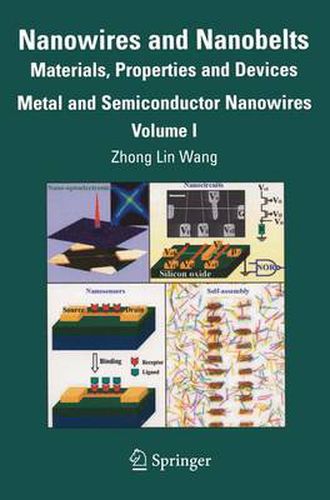Readings Newsletter
Become a Readings Member to make your shopping experience even easier.
Sign in or sign up for free!
You’re not far away from qualifying for FREE standard shipping within Australia
You’ve qualified for FREE standard shipping within Australia
The cart is loading…






Nanowires, nanobelts, nanoribbons, nanorods …, are a new class of quasi-one- dimensional materials that have been attracting a great research interest in the last few years. These non-carbon based materials have been demonstrated to exhibit superior electrical, optical, mechanical and thermal properties, and can be used as fundamen- tal building blocks for nano-scale science and technology, ranging from chemical and biological sensors, field effect transistors to logic circuits. Nanocircuits built using semiconductor nanowires demonstrated were declared a breakthrough in science by Science magazine in 2001. Nature magazine recently published a report claiming that Nanowires, nanorods, nanowhiskers, it does not matter what you call them, they are the hottest property in nanotechnology (Nature 419 (2002) 553). There is no doubt that nanowire based quasi-one-dimensional materials will be the new focal point of research in the next decades. Volume 1: Metal and Semiconductor Nanowires covers a wide range of mate- rials systems, from noble metals (such as Au, Ag, Cu), single element semiconductors (such as Si and Ge), compound semiconductors (such as lnP, CdS and GaAs as well as heterostructures), nitrides (such as GaN and SiN ) to carbides (such as SiC). The 3 4 of this volume is to cover the synthesis, properties and device applications objective of nanowires based on metal and semiconductor materials. The volume starts with a review on novel electronic and optical nanodevices, nanosensors and logic circuits that have been built using individual nanowires as building blocks.
$9.00 standard shipping within Australia
FREE standard shipping within Australia for orders over $100.00
Express & International shipping calculated at checkout
Nanowires, nanobelts, nanoribbons, nanorods …, are a new class of quasi-one- dimensional materials that have been attracting a great research interest in the last few years. These non-carbon based materials have been demonstrated to exhibit superior electrical, optical, mechanical and thermal properties, and can be used as fundamen- tal building blocks for nano-scale science and technology, ranging from chemical and biological sensors, field effect transistors to logic circuits. Nanocircuits built using semiconductor nanowires demonstrated were declared a breakthrough in science by Science magazine in 2001. Nature magazine recently published a report claiming that Nanowires, nanorods, nanowhiskers, it does not matter what you call them, they are the hottest property in nanotechnology (Nature 419 (2002) 553). There is no doubt that nanowire based quasi-one-dimensional materials will be the new focal point of research in the next decades. Volume 1: Metal and Semiconductor Nanowires covers a wide range of mate- rials systems, from noble metals (such as Au, Ag, Cu), single element semiconductors (such as Si and Ge), compound semiconductors (such as lnP, CdS and GaAs as well as heterostructures), nitrides (such as GaN and SiN ) to carbides (such as SiC). The 3 4 of this volume is to cover the synthesis, properties and device applications objective of nanowires based on metal and semiconductor materials. The volume starts with a review on novel electronic and optical nanodevices, nanosensors and logic circuits that have been built using individual nanowires as building blocks.